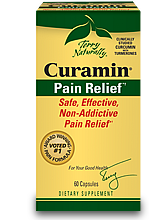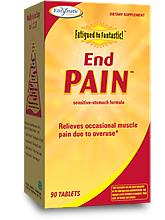Outstanding Herbal Pain Relief
Many natural therapies can be very helpful for pain. My three favorite pain relieving herbals are willow bark, Boswellia, and cherry. All three of these can be found in combination in an herbal supplement that provides relief for pain (with boswellia and white willow bark; or Curcumin, boswellia, nattokinase, and DLPA). For fibromyalgia or arthritis pain, take the maximum dose until maximum benefit is achieved (about 4-6 weeks) and then one can use the lowest effective dose.
Although this excellent herbal mix may start working after the first dose, it dramatically increases in effectiveness after one week and even much more so at six weeks. It can be taken in combination with any other pain medications, and the dose of these medications can often be lowered after 4-6 weeks. Another benefit: side effects with these herbals are extremely rare.
Although medications are sometimes needed for pain relief, they often are associated with significant side effects and also high cost. The good news is that natural remedies are often very effective (often much more effective than the medications), inexpensive, and fairly free of side effects. The natural herbal mix discussed in this article can also be taken safely with other prescription pain medications, and after 4-6 weeks of use will often allow the pain medication dose to be decreased or even eliminated. I recommend taking two tablets three times a day until pain is maximally relieved (usually 1-6 weeks), and then the dose can be lowered as able.
Willow bark is the original source of aspirin, but when used as the entire herb it has been found to be much safer and quite effective. The active ingredient is salicin, and willow bark has been shown to be effective in both osteoarthritis and back pain. Like aspirin and Celebrex, it acts as a COX (Cyclooxygenase enzyme) inhibitor, decreasing inflammation. There are clearly a combination of other factors in willow bark that markedly enhance its effectiveness and safety — which can be a major benefit over aspirin and NSAIDs (e.g., Motrin) — which cause an enormous amount of gastritis and ulcer bleeding, to the point of killing 15,000-20,000 Americans yearly! The studies on willow bark are quite consistent in their effectiveness in reducing pain. Let's look at some of the research.
In one study, 210 patients with severe chronic low back pain were randomly assigned to receive an oral willow bark extract with either 120 mg (low dose) or 240 mg (high dose) of salicin, or placebo, in a 4-week blinded trial. In the last week of therapy, 39% in the group receiving high-dose extract were pain free, 21% in the group receiving low-dose extract were pain free, and only 6% in the placebo group were pain free (P < 0.001). The response in the high-dose group was evident after only 1 week of therapy.2 They then studied 451 patients who came in with low back pain in an open study, using salicin 240 mg, 120 mg, or standard orthopedic/NSAID care for four weeks. 40% of the patients in the 240 mg group and 19% in the 120 mg group were pain free after 4 weeks. In the standard therapy group using standard medications, only 18% were pain free. The study showed that willow bark was not just far more effective and safer than standard prescription therapies, but also decreased the cost of care by approximately 40%!3
Another review found that willow bark extract has comparable anti-inflammatory activities as higher doses of acetylsalicylic acid/aspirin (ASS), as well as reducing pain and fever. In pharmacologically active doses, no adverse effects on the stomach lining (e.g., indigestion, ulcers, etc) were observed, in contrast to aspirin. A daily dose of willow bark extract standardized to 240 mg salicin per day was also significantly superior to placebo in patients with osteoarthritis of the hip and the knee. In 2 open studies against standard active therapies as controls, willow bark extract exhibited advantages compared to NSAIDs and was about as effective as Vioxx.4 Another placebo-controlled study found that willow bark (salicin 240 mg/day) was more effective than placebo in addressing arthritis (the normal wear and tear type called osteoarthritis) after only two weeks of therapy.5 Other studies are also available for those of you who would like more information on willow bark.6-9
All of this makes willow bark a wonderful natural pain medicine. It is safe and effective for arthritis, back pain, and likely many other types of pain! I would begin with enough to get 240 mg of Salicin a day (6 tablets) until maximum benefit is seen. At that point, you may be able to lower the dose to 120 mg or less a day and/or take it as needed.
Boswellia Serrata, also known as Frankincense, has been used in traditional Ayurvedic medicine for centuries. Boswellia has been found to be quite helpful in addressing inflammation and pain10-15 and it also does this without causing ulcers like aspirin family medications.16 It has been shown in studies to be helpful for both rheumatoid arthritis17 and osteoarthritis.18
In the latter study, 30 patients with osteoarthritis of the knee were given 1,000 mg of an extract of Boswellia or placebo for eight weeks and then the groups were switched for the next eight weeks. All of the patients on the Boswellia showed significantly decreased pain and improved ability to walk. In fact, the improvement was quite remarkable with the pain index falling by 90% after eight weeks with a similarly dramatic increase in function. This was recently discussed at more length in the wonderful patient oriented newsletter "Nutrition and Healing" by Jonathan Wright M.D. — a physician who I have great respect for (visit Dr. Wright's website).
Boswellia has also been demonstrated to have significant anti-inflammatory properties, inhibiting leukotriene synthesis by inhibiting 5-lipooxygenase activity. It also decreases the activity of human leukocyte elastase (HLE). Interestingly, elevated elastase has been implicated in chronic fatigue syndrome and fibromyalgia pain. Blocking 2 inflammatory chemicals that are increased simultaneously in a variety of human diseases is unique to Boswellia.15 This results in its being helpful in asthma and colitis as well as pain. In one study of asthmatics, 40 patients were given 300 mg 3 times day for 6 weeks. 70% of the asthma patients showed improvement in symptoms and lung function and a decrease in allergic blood cells (eosinophils).20 Boswellia also helped in the therapy of ulcerative colitis. In one study giving Boswellia 300 mg 3 times a day for 6 weeks, out of 20 patients given Boswellia gum resin, 14 went into remission, while with sulfasalazine (the standard prescription therapy) the remission rate was 4 out of 10.21 Test tube studies suggest that Boswellia also markedly inhibits cancer.22-23
It does not appear to have any major side effects that resulted in people withdrawing from the studies, but it does rarely cause minor gastrointestinal disturbances or rash. A common dose is 150-350 mg 3 times a day.
Cherry Fruit (Prunus cerasus) — Although there are not as many human studies on the use of tart cherries, they also contain compounds which inhibit COX-1 (inflammation)24 and cherries possess both antioxidant and anti-inflammatory properties. In addition, research suggests that it may also inhibit colon cancer and perhaps other cancers.25 Cherries and other colored berries are very high in many antioxidants. As with eating cherries, taking cherry fruit is quite safe. Many people are finding that simply eating 10-20 cherries a day has been helping their arthritis considerably. 2,000 mg of cherry fruit extract (present in the maximum dose of an herbal supplement that provides relief for pain) contains the active components present in 10 cherries or 32 oz of cherry juice. Early research, as well as how many people come back for more after they have tried it (which to me is a significant indicator of effectiveness), suggests that cherry fruit holds a lot of promise!25-28
References
The footnotes above can be found in the book Pain Free 1-2-3 and are also available upon request.

Jacob Teitelbaum, M.D. is one of the most frequently quoted post viral CFS, fibromyalgia, energy, sleep and pain medical authorities in the world. He is the author of 12 books including You Can Heal from Long Covid, the best-selling From Fatigued to Fantastic!, Pain Free 1-2-3, The Complete Guide to Beating Sugar Addiction, Real Cause Real Cure, The Fatigue and Fibromyalgia Solution, and the popular free Smart Phone app Cures A-Z. He is the lead author of eight research studies and three medical textbook chapters on effective treatment for fibromyalgia and chronic fatigue syndrome. Dr. Teitelbaum appears often as a guest on news and talk shows nationwide, including past appearances on Good Morning America, The Dr. Oz Show, Oprah & Friends, CNN, and FoxNewsHealth.
Websites: Vitality101.com | EndFatigue.com
Facebook Support Group: Recovering from Fibromyalgia, Chronic Fatigue, and Long COVID
Facebook Page | Instagram



